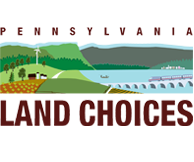Land trusts, like most nonprofits, have faced substantial challenges in fundraising due to the weak economy. Across the nation, land trusts, strongly motivated to advance their conservation work in spite of adversity, have sought creative and innovative solutions to maintaining sustainability. Many have pursued strategic alliances – mergers and organizational restructuring – with the goal of improving their conservation outcomes and advancing their missions. In just this past year, Pennsylvania land trusts established three new strategic alliances, each a unique solution for moving forward.
Natural Lands Trust and Montgomery County Lands Trust
Montgomery County Lands Trust (MCLT) and the Natural Lands Trust (NLT) have enjoyed a close working relationship for over ten years. The two organizations’ long history of collaboration entered a new chapter in July, when MCLT and NLT, in order to advance their missions and better support the conservation needs of the region, joined forces through an affiliation agreement. As an affiliate of NLT, MCLT will continue its mission of protecting open space in Montgomery County. Declining resources served as a major catalyst for moving the process forward. Over the past several years, as funding sources became scarce, Dulcie Flaharty, MCLT Executive Director, recognized the need to consider how best to continue the mission of MCLT. “MCLT found it very challenging to be vibrantly active with responsibilities for land preservation and educational programs,” she explained. “Joining forces with NLT would give us the ability to blend our expertise with NLT’s vast resources, thus continuing the much needed conservation work in Montgomery County.”
The organizations agreed on an affiliation relationship in which MCLT became a 509(a)(3) supporting organization of NLT with MCLT dissolving its board and NLT’s board becoming the overseer of the land trust. Two MCLT stakeholders, including one board member and one staff member, joined NLT’s board. Under the affiliation agreement, a land preservation committee was established to focus on conservation efforts in Montgomery County.
Organizational leaders believe that the affiliation relationship will ultimately empower MCLT and NLT to be more effective in moving conservation forward and managing the challenges and issues of the region. Molly Morrison, President of NLT, acknowledges the challenges of absorbing the additional tasks and responsibilities to serve and manage the new affiliation but sees this new role as “an opportunity, not a burden”.
“This has been a challenging experience but in the end, has fostered a rewarding relationship,” explained Dulcie, “MCLT’s last board meeting was bittersweet since it signified the end of a chapter in some ways; but it also means the beginning of a new chapter for MCLT and there is great comfort in knowing the board effectively delivered their mission to the next generation of caretakers.”
Delaware Highlands Conservancy and the Eagle Institute
Like the NLT and MCLT alliance, a collaborative relationship preceded the Delaware Highlands Conservancy (DHC) and Eagle Institute (EI) move to merger.
Since its founding in 1994, DHC has conserved more than 13,000 acres around the Upper Delaware River. EI formed in 1998 to support the return of the endangered eagle to the Upper Delaware River region. For years, the two organizations communicated regularly. This evolved into hosting joint educational and outreach programs and, most recently, working together on a large land conservation project.
When EI’s founder and Executive Director, Lori McKean, felt the organization was at a crossroads, she decided to reach out to the Executive Director of DHC, Sue Currier, to discuss the possibilities of a merger. After several meetings with Lori, Sue brought the matter to DHC’s board president and financial committee, which expressed interest in exploring the concept.
After many meetings and an internal due diligence process, condcuted by DHC’s board, the conditions of the merger were established and approved by both boards. Per these terms, the institute would be dissolved and its assets transferred to the conservancy. In its place, DHC would form the Eagle Institute Committee to guide and perform the work of the institute.
The organizations announced the merger in spring 2012. To celebrate, DHC worked with one of EI’s partners, the Basha Kill Area Association, to hold two guided eagle tours.. The tours offered eagle enthusiasts an opportunity to experience and learn more about these majestic birds of prey and the conservation efforts in the region that help sustain the eagle population. The event helped to illustrate how the partnership will continue to grow and the efforts of the institute will move forward, through the support of DHC.
Sue Currier admits there is a lot to be done but the overall outlook moving forward is optimism and enthusiasm. “Coming together with the Eagle Institute means we’re stronger. In these days of doing more with less, leveraging the resources of both organizations means those resources will go further.”
With this in mind, Currier envisions future collaborations. “I can see the Conservancy looking to other organizations to explore opportunities to merge,” she explains.
Lancaster County Conservancy and LIVE Green
In Lancaster County, it was a strategic planning objective and a funding shortfall that led to the synergistic alliance of two very different organizations.
In its 2008 strategic plan, the Lancaster County Conservancy (LCC) recognized a need to actively engage the “urban and suburban population and landscape” in its conservation mission. In 2010, after experiencing massive budget cuts, LIVE Green an organization founded in 2004 to support urban greening initiatives, decided to reach out to community organizations to establish an alliance.
After a few conversations, the two organizations realized the possibility for a partnership. With community foundation support, a consulting firm was brought in to guide the two organizations through the process of establishing a conceptual agreement. Working groups were organized to address the primary areas of integration, including governance, development, financial and information systems, human resources and staffing, program, and communications.
In December 2011, merger documents were finalized and filed. LIVE Green was incorporated into LCC as a new program, with its program director hired by LCC to manage the program. LIVE Green was dissolved and its assets transferred to LCC. Live Green’s executive director, technically a paid consultant and not a staff member, was hired by LCC. Two members of the LIVE Green board were added to LCC’s board; in addition, LCC agreed to expand and diversify its board in the future to include urban stakeholders that would better complement LIVE Green’s mission.
“The Conservancy sees the merger with LIVE Green as a way to integrate land protection with water quality and stormwater management in urban areas of the county,” explains Ralph Goodno, LCC’s CEO and President. In addition, the integration of these organizations increases our visibility and expands our constituency. We are convinced that this merger will then extend our reach and influence and increase our donor and volunteer base.”
Merger restructurings are unique to each situation. What might work well in one circumstance may not in another. Trust, communication and cooperation are key no matter how a restructuring is approached.
____________________________________________
See Mergers at ConservationTools.org for guidance on land trust mergers and additional examples.






